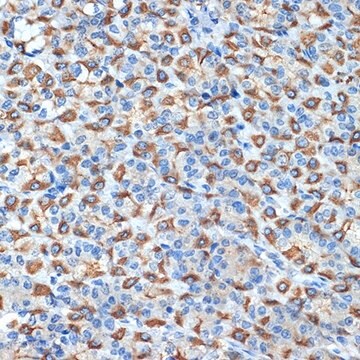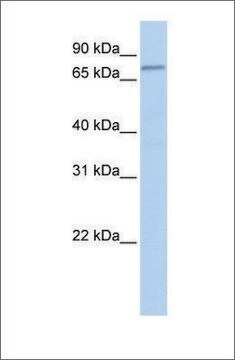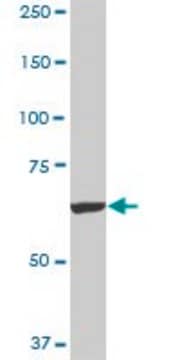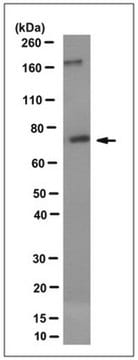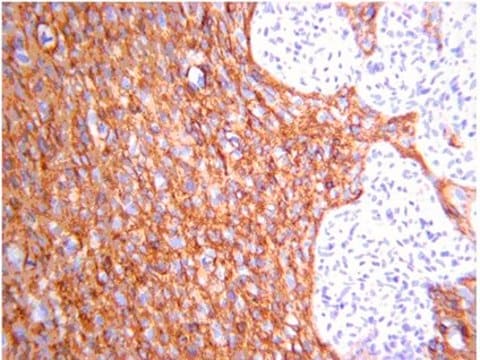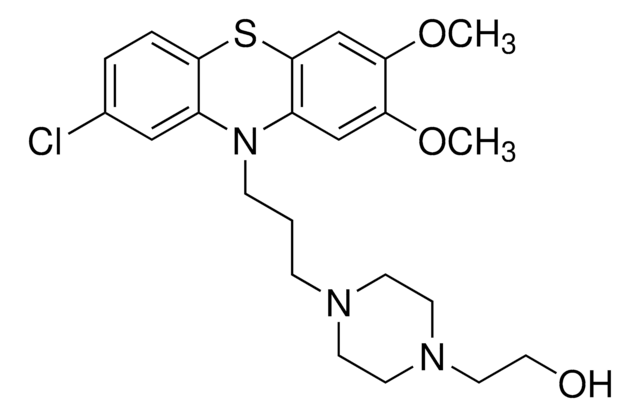推薦產品
生物源
mouse
共軛
unconjugated
抗體表格
purified immunoglobulin
抗體產品種類
primary antibodies
無性繁殖
polyclonal
形狀
buffered aqueous solution
分子量
antigen ~77.8 kDa
物種活性
human
技術
western blot: 1 μg/mL
NCBI登錄號
UniProt登錄號
運輸包裝
dry ice
儲存溫度
−20°C
目標翻譯後修改
unmodified
基因資訊
human ... FBXO42(54455)
一般說明
Members of the F-box protein family, such as FBXO42, are characterized by an approximately 40-amino acid F-box motif. SCF complexes, formed by SKP1 (MIM 601434), cullin (see CUL1; MIM 603134), and F-box proteins, act as protein-ubiquitin ligases. F-box proteins interact with SKP1 through the F box, and they interact with ubiquitination targets through other protein interaction domains (Jin et al., 2004 [PubMed 15520277]).[supplied by OMIM
免疫原
FBXO42 (AAH43410.1, 1 a.a. ~ 716 a.a) full-length human protein.
Sequence
MASSSDSEDDSFMAVDQEETVLEGTMDQDEEPHPVLEAEETRHNRSMSELPEEVLEYILSFLSPYQEHKTAALVCKQWYRLIKGVAHQCYHGFMKAVQEGNIQWESRTYPYPGTPITQRFSHSACYYDANQSMYVFGGCTQSSCNAAFNDLWRLDLNSKEWIRPLASGSYPSPKAGATLVVYKDLLVLFGGWTRPSPYPLHQPERFFDEIHTYSPSKNWWNCIVTTHGPPPMAGHSSCVIDDKMIVFGGSLGSRQMSNDVWVLDLEQWAWSKPNISGPSPHPRGGQSQIVIDDATILILGGCGGPNALFKDAWLLHMHSGPWAWQPLKVENEEHGAPELWCHPACRVGQCVVVFSQAPSGRAPLSPSLNSRPSPISATPPALVPETREYRSQSPVRSMDEAPCVNGRWGTLRPRAQRQTPSGSREGSLSPARGDGSPILNGGSLSPGTAAVGGSLDSPVQAISPSTPSAPEGYDLKIGLSLAPRRGSLPDQKDLRLGSIDLNWDLKPASSSNPMDGMDNRTVGGSMRHPPEQTNGVHTPPHVASALAGAVSPGALRRSLEAIKAMSSKGPSASAALSPPLGSSPGSPGSQSLSSGETVPIPRPGPAQGDGHSLPPIARRLGHHPPQSLNVGKPLYQSMNCKPMQMYVLDIKDTKEKGRVKWKVFNSSSVVGPPETSLHTVVQGRGELIIFGGLMDKKQNVKYYPKTNALYFVRAKR
Sequence
MASSSDSEDDSFMAVDQEETVLEGTMDQDEEPHPVLEAEETRHNRSMSELPEEVLEYILSFLSPYQEHKTAALVCKQWYRLIKGVAHQCYHGFMKAVQEGNIQWESRTYPYPGTPITQRFSHSACYYDANQSMYVFGGCTQSSCNAAFNDLWRLDLNSKEWIRPLASGSYPSPKAGATLVVYKDLLVLFGGWTRPSPYPLHQPERFFDEIHTYSPSKNWWNCIVTTHGPPPMAGHSSCVIDDKMIVFGGSLGSRQMSNDVWVLDLEQWAWSKPNISGPSPHPRGGQSQIVIDDATILILGGCGGPNALFKDAWLLHMHSGPWAWQPLKVENEEHGAPELWCHPACRVGQCVVVFSQAPSGRAPLSPSLNSRPSPISATPPALVPETREYRSQSPVRSMDEAPCVNGRWGTLRPRAQRQTPSGSREGSLSPARGDGSPILNGGSLSPGTAAVGGSLDSPVQAISPSTPSAPEGYDLKIGLSLAPRRGSLPDQKDLRLGSIDLNWDLKPASSSNPMDGMDNRTVGGSMRHPPEQTNGVHTPPHVASALAGAVSPGALRRSLEAIKAMSSKGPSASAALSPPLGSSPGSPGSQSLSSGETVPIPRPGPAQGDGHSLPPIARRLGHHPPQSLNVGKPLYQSMNCKPMQMYVLDIKDTKEKGRVKWKVFNSSSVVGPPETSLHTVVQGRGELIIFGGLMDKKQNVKYYPKTNALYFVRAKR
生化/生理作用
FBXO42 (F-box protein 42) works in the ubiquitin-proteasome system and is involved in protein degradation. It mainly participates in the assembly of the SCF (skp, cullin, F-box containing) complex. FBXO42 is responsible for the ubiquitination and subsequent degradation of p53. It is also involved in the ubiquitination and degradation of ING4 (inhibitor of growth family member 4), thereby enhancing angiogenesis and metastasis of breast cancer. FBXO42 might be associated with Parkinson′s disease (PD).
外觀
Solution in phosphate buffered saline, pH 7.4
Not finding the right product?
Try our 產品選擇工具.
儲存類別代碼
10 - Combustible liquids
水污染物質分類(WGK)
WGK 1
閃點(°F)
Not applicable
閃點(°C)
Not applicable
分析證明 (COA)
輸入產品批次/批號來搜索 分析證明 (COA)。在產品’s標籤上找到批次和批號,寫有 ‘Lot’或‘Batch’.。
Kai Gao et al.
BMC neurology, 13, 125-125 (2013-09-26)
Parkinson's disease (PD), the second most common neurodegenerative disease, is characterized by loss of dopaminergic neurons in the substantia nigra. The clinical manifestations of PD encompass a variety of motor and non-motor symptoms. Mutations in the F-box protein 7 gene
Ruorong Yan et al.
Genes & development, 29(6), 672-685 (2015-03-21)
Loss of function/dysregulation of inhibitor of growth 4 (ING4) and hyperactivation of NF-κB are frequent events in many types of human malignancies. However, the molecular mechanisms underlying these remarkable aberrations are not understood. Here, we report that ING4 is physically
Luyang Sun et al.
Proceedings of the National Academy of Sciences of the United States of America, 106(25), 10195-10200 (2009-06-11)
The p53 tumor suppressor plays a central role in integrating cellular responses to various stresses. Tight regulation of p53 is thus essential for the maintenance of genome integrity and normal cell proliferation. Currently, several ubiquitin ligases, including the single-subunit RING-finger
Luyang Sun et al.
The Journal of biological chemistry, 286(6), 4226-4235 (2010-12-04)
The p53 tumor suppressor plays a central role in integrating cellular responses to various stresses. Tight regulation of p53 is thus essential for the maintenance of genome integrity and normal cell proliferation. Previously, we reported that JFK, the only Kelch
我們的科學家團隊在所有研究領域都有豐富的經驗,包括生命科學、材料科學、化學合成、色譜、分析等.
聯絡技術服務